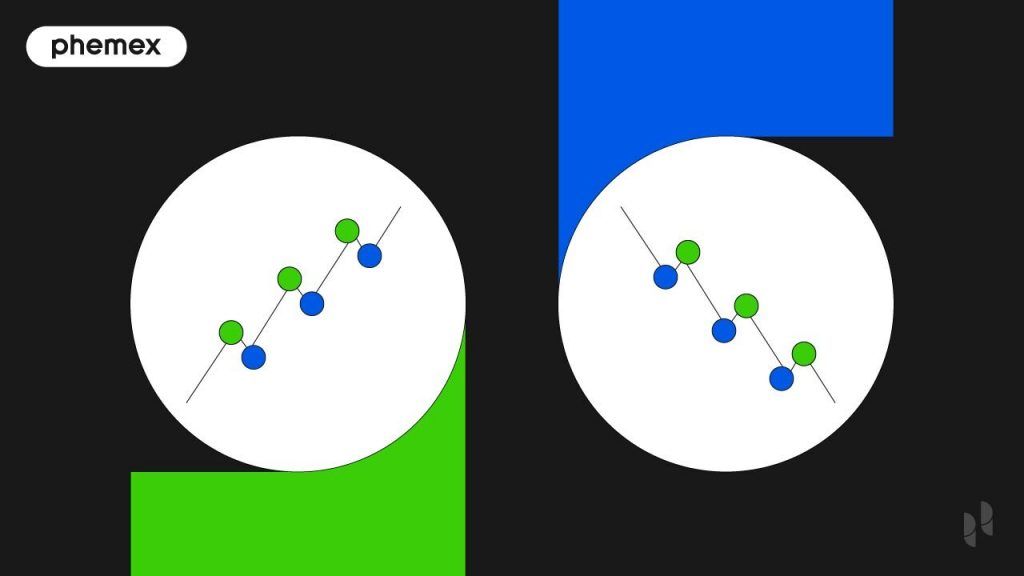What is The Weighted Moving Average?
Weighted Moving Average is a moving average (MA) indicator that measures the trend direction of Bitcoin (BTC). The WMA indicator focuses on data from recent daily closes on Bitcoin and forecasts market movement in the short-term. The WMA indicator is faster than indicators such as the Simple Moving Average (SMA).
The WMA indicator is a simple line that trends near the Bitcoin candles. It can be used in conjunction with other moving average indicators to predict future price movements. If the bars on the Bitcoin chart fall below the WMA line, this indicates a bullish trend. If the bars are above the WMA line, this indicates a bearish trend.
The speed at which it calculates trends makes it a leading indicator, which is ideal for predicting how the price action might unfold over the next few days. The “weight” factor signifies the weight of each bar over a set period. The WMA formula smoothens out data and makes it easier for traders to trade proactively.

Summary:
- Moving average is a tool that measures the average price of Bitcoin and other crypto assets.
- There are multiple moving average indicators such as Exponential Moving Average (EMA), Simple Moving Average (SMA), Weighted Moving Average (WMA), and more.
- The Weighted Moving Average, or WMA, is one of the most popular moving average indicators. The name “weighted” is derived from the weight it places on data from recent periods.
- The WMA formula is derived by multiplying averages in the daily Bitcoin price by a certain weight. Higher prices carry a higher weight, and lower prices carry a lower weight.
- The WMA indicator places an emphasis on recent data and ignores historic data. If we select 9 periods, it will only analyze data based on the last 9 days and ignore all price action that existed beforehand.
- Compared to indicators such as SMA or EMA, the WMA indicator moves faster. This helps the WMA indicator predict future trends ahead of time and serves as a leading indicator.
- A reliable trading strategy is to use the indicator on the daily chart and wait for the candles to reverse below the WMA line prior to opening a long trade. Conversely, a short trade can be opened when the VMA line is above the candles.
- The WMA indicator is available on all Phemex spot market and futures trading pairs.

Who Invented The Weighted Moving Average?
The Weighted Moving Average was invented by John J. Murphy, a New York-based financial analyst. While moving averages were used in the stock markets for 100+ years, the WMA indicator was first introduced in 1999 in J. Murphy’s thesis called “Technical Analysis of The Financial Markets”. The thesis was published in the New York Institute of Finance.

MA indicators: WMA (blue), SMA (red), and EMA (yellow).
Murphy claimed that the financial markets were lacking a moving average that places an emphasis on recent data. The existing moving average indicators were providing lagging data, and this indicator could predict trends while they were occurring in the moment. It’s currently one of the popular moving average indicators.
Weighted Moving Average Formula
The Weighted Moving Average formula identifies averages for certain periods, assigns a number to each average, multiplies them by the period and divides them. Here is how to calculate a weighted moving average:

How to Calculate Using The Weighted Moving Average Formula?
Let’s say we want to calculate the 3 week weighted moving average. If the average Bitcoin price is $40,000 for the first week, $41,000 for the second week, and $42,000 for the third week we can assign weight to each one of these based on the price difference.
The third week would be assigned a weight of “1” because it’s the largest number with the most weight at $42,000. The second week would get “2” because it’s the second largest number, and the first week would get “3” as the smallest number. We then have to calculate the sum of those periods (1 + 2 + 3) for the divider.
Once we multiply each price by the assigned value and divide by the period number we get the WMA for the past three weeks. It would require the following calculation: [(1 x $42,000) + (2 x $41,000) + (3 x $40,000)] / 6. The result is 244,000 / 6 = 40,666. The WMA for the past three weeks is $40,666.
How To Trade With The WMA Indictor on Phemex?
The WMA indicator is available under all Phemex spot market and futures trading pairs. Select any pair, such as BTC/USDT and load the chart:

The Bitcoin chart is the most-traded chart in crypto.
Click on “Indicators” at the top and search for “Moving Average Weighted”:

Find for your favorite indicator using our search engine.
Left-click on the indicator and it will automatically load beneath the chart. For this demonstration, we are using the daily chart but you can choose any time period in the top-left:

The WMA indicator is active on the daily Bitcoin chart.
On Phemex, the weighted moving average is calculated automatically. The WMA indicator trails behind the candles as a blue line – allowing traders to open long or short trades accordingly. If we zoom in to the present moment on the daily chart, we can check which trend formations are occurring:

According to the WMA indicator, Bitcoin is currently in a downtrend as the candles are trading below the WMA line. It was trading underneath the WMA indicator line for the past 6 days, with no indication of a reversal.
Traders could open a short trade or wait until the trend starts reversing again. If the WMA line starts moving upwards, this indicates a trend reversal and a good long trade opportunity. If we open a long trade without the line changing direction, we are increasing our risk exposure as it goes against the current trend.
Weighted moving average forecasting is used for confirming the trend direction. The current trend direction is bearish and the indicator currently confirms a downtrend for a trader looking to short. A trader looking for long opportunities would have to wait until the WMA line starts going up to confirm the trend.

Moving Average vs Weighted Moving Average: Is The MA Different From The WMA?
The difference between the moving average vs weighted moving average is that the moving average indicator accounts for historic data while the WMA indicator accounts for recent data only. There are over a dozen moving average indicators on Phemex and all of them can be used simultaneously.
The most used MA indicator aside from WMA is the SMA. The Simple Moving Average, or SMA, works similarly to the WMA by calculating averages and trailing the Bitcoin candles with a single line. The difference between Simple Moving Average and Weighted Moving Average is that the WMA is faster without many delays.

MA (dark red), EMA (yellow), SMA (light red), and WMA (blue).
We can see that the WMA has gone down further than other indicators. This is because it acts without delays and confirms the bearish trend instantly. Traders can solidify their trading bias using the WMA because the speed at which it develops indicates there’s no reversal on the horizon.
WMA is generally the most sensitive moving average indicator. We can expect that it’s going to move faster than all other indicators combined. The advantage is that we are aware of trend formation in real-time and can act upon this information without delays. The disadvantage is that it only accounts for recent data and can give false signals.
What Is The Best WMA Trading Strategy?
Moving average indicators are often combined with Bollinger Bands to account for support and resistance levels. Bollinger Bands are based on moving averages and the lines are often in the middle of the bands. If the Bitcoin candles fall below the Bollinger Band barriers, we have a long opportunity:

Moving Average indicators in the middle of Bollinger Bands.
In this case, we can see that Bitcoin has depreciated below the lower barrier of the Bollinger Bands and that the WMA is heading downwards. The candles breaking the lower barrier of the Bollinger Bands potentially indicate a support level and a trend reversal. Bitcoin also saw price divergence when the candles went above the upper barrier on the daily chart.
We can deploy momentum oscillator indicators to confirm how long-term price movement aligns with the current price action provided by the WMA indicator. For instance, the Coppock Curve indicator tracks long-term price changes and signals when there’s a major reversal:

According to the Coppock Curve, Bitcoin has been in a downward trend for the past month and is nearing support levels where it saw a reversal in the past. This long-term indicator signals that Bitcoin could continue going down in the short-term, and then reverse to the upside promptly.
Conclusion
The WMA indicator was not designed to identify support and resistance levels. Similar to other moving average indicators, it should only be used to confirm a trend. To learn when to use a weighted moving average, you should start with long-term indicators such as Bollinger Bands. Long-term indicators such as the Coppock Curve, which can provide additional confirmation.
The WMA is superior to other moving average indicators for short-term trends and is the most sensitive MA indicator. The formula is based on recent price data, giving it an advantage over other indicators by filtering out historic price patterns. Traders that use trading bots or prefer leading indicators will benefit from the short-term trend data this indicator can provide them.
Read More
- What is, And How to Trade Crypto With The Moving Average?
- SMA Trading Strategies for Crypto Trading
- Exponential Moving Average (EMA): The Most Important Moving Average Indicator
- VWAP Trading: How To Trade With The VWAP Indicator?
- What is MESA Adaptive Moving Average Indicator (MAMA)?
- What is The Least Squared Moving Average (LSMA): How To Trade With This Indicator?
- What Is Average Price Indicator: How To Trade Bitcoin With Daily Average Price
- What is Mass Index (MI): The Best Reversal-Trading Indicator for Crypto








